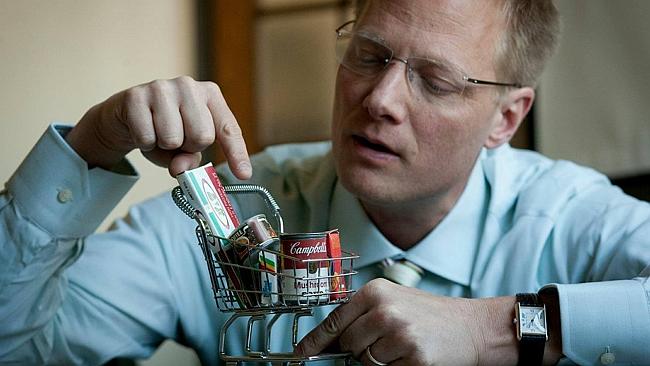
Professor Brian Wansink and his team are leading the way in food psychology. Source: Supplied
DIETING is a loser’s game, according to a leading New York professor, since using willpower is a constant effort.
Instead, we need to mindlessly eat less, and eat what’s good for us.
It may sound far-fetched, but Brian Wansink says it’s simply a matter of tricking your brain.
His team at Cornell University’s Food and Brand Lab specialises in food psychology, and Prof Wansink has written two books on how to make healthy eating second nature.
His latest, Slim by Design, says we can set ourselves up for success by tweaking our environment in five places — at home, in restaurants, in the grocery store, at the office and at school.

Don’t have food visible on work surfaces, and serve fruits and vegetables first. Source: Supplied
The ideal kitchen counter is free of any foodstuffs, bar a bowl of fruit. The team found that even people who only had healthy muesli on show weighed 10 kilos more on average than those who kept edibles out of sight.
We will eat most of what is served first, so start meals with salad and vegetables. Plate up in the kitchen so you’re not tempted to eat more, and use fairly small plates, around 22-25cm wide. A high colour contrast between the food and plate will make you more aware of your serving size. Drink from narrow glasses and set your glass on the table before pouring.
Make sure your fridge always contains six servings of lean protein, such as eggs, sliced turkey, yoghurt, tofu and soft cheese. Place precut fruits and vegetables on a middle shelf and don’t keep more than two cans of soft drink in there. Store snacks in one inconveniently-placed cupboard.
Television affects how you eat too. “With action movies, people seem to eat to the pace of the movie,” said Aner Tal, a Cornell researcher and co-author. “But movies can also generate emotional eating, and people may eat to compensate for sadness.”
People watching tearjerkers ate between 28 per cent and 55 per cent more of anything in front of them. Prof Wansink says we can manipulate this situation to create a quick and mindless way of getting more fruit and veg into our diet.
The team advise people to think of a workout as a “fun run” or as a well-deserved break, to ensure we don’t reward ourselves with too much food afterwards. Think of it as exercise and you’ll later eat more dessert and snacks to reward yourself. “Anything that brings a smile is likely to get you to eat less,” said Prof Wansink.
The team also recommend weighing yourself regularly, although they warn that weight fluctuates during the week, and we tend to weigh more on weekends. If you weigh-in weekly, do it on a Wednesday, when the reading will be most accurate.
Prof Wansink’s team visited restaurants across the US, mapping out layouts and collecting diners’ receipts. They discovered that people ordered more healthy food if they sat by a window with lots of light or on high stools that make you sit up straighter, and more fried food if they were near to a TV.
Parties seated near the bar drank more beers and mixed drinks than those further away. Dim light and loud music encouraged over-eating, perhaps because of that feeling of invisibility.
If you’re in a group, Prof Wansink suggests you aim to be the last to start eating and first to finish, and dine with slim friends to emulate their habits. In a buffet-style restaurant, sit far away from the food and choose a seat facing in the other direction. If chopsticks are an option, use them over cutlery, and place your napkin on your lap.
The slower you eat, the less you will consume and the more you’ll enjoy your food, so choose fine dining over fast-food restaurants, and take your time.
When you go to the grocery store, chew a piece of gum to distract your imagination from the taste of the food you see. Wheel through as many of the fresh produce aisles as possible.
Divide your trolley or basket in half — fruits and vegetables in the front and all the other food in the back. This can lead you to buy 23 per cent more fruit and veg.
We usually buy more of the first things we see, so shop at a stores that place the healthiest foods (produce, whole grains, canned vegetables) in aisles 1 to 3 and at eye level.
Make sure your desk at work is tidy and junk-food free. People who have snacks in or on their desk reported weighing seven kilos more than those who didn’t.

Wheel your trolley through all the fresh produce aisles at the store. Source: Supplied
At work, try to sit within 15 seconds of a water fountain, and close to the kitchen, so you can bring in healthy lunches. Always use the stairs, and leave your desk at lunchtime.
Prof Wansink believes the revolution in healthy eating will come not from persuading people to make better choices, but by creating environments that make it automatic.
He encourages office workers to write to bosses and HR managers, customers to write to their grocery stores and restaurants and parents to write to head teachers to suggest improvements. These range from regular wellness seminars to discount gym membership, to making healthy salads readily available in the canteen.
If we create these environments from our school canteen onwards, healthy habits will become utterly natural.
Find out more about Brian Wansink’s book Slim by Design: Mindless Eating Solutions for Everyday Life and find tools to use in everyday life on his website.
Originally published as Trick your brain into eating well
